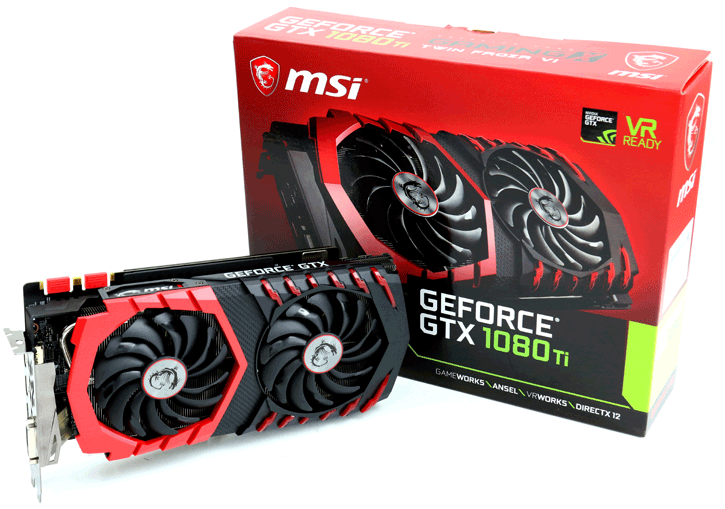Introduction
MSI GTX 1080 Ti GAMING X reviewed & benchmarked
The clash with the Titan
With the reference boards being reviewed, the AIB partners from Nvidia now have their custom boards ready. In this article we'll look at the fastest graphics card your money can get you, the Nvidia GeForce GTX 1080 Ti based on Pascal architecture. Armed with 11GB of GDDR5X graphics memory and an all new GP102-350 GPU, we are certainly we're gonna break some records today. It has been eight months since Nvidia released the first GP102 based product, the Titan X. To date, a massively impressive graphics card that will resemble what we review today and very similar on a lot of levels. Really, the 1080 Ti is the Titan X, just with one GB of that GDDR5X memory less and the one ROP partition tied to it. So let me break it down swift and fast, the new high-end GTX 1080 Ti features 3584 CUDA Cores, 224 Texture Units, a 352-bit memory controller and 11 GB of faster (11 Gbps) GDDR5X memory. The card has the same "GP102" GPU as the TITAN X Pascal, but the GTX 1080 Ti was slighty reconfigured. Most interesting is the 352-bit wide GDDR5X memory interface, this was not expected. This translates to 11 memory chips on the card which run at 11 GHz (GDDR5X-effective), the memory bandwidth is 484 GB/s. This invokes the change in ROP count to 88 (from 96 on the TITAN X Pascal), and the TMU count of 224. A reference Ti card will boost up to roughly 1600 MHz, but the overclocking potential (boost requency) is much like all GeForce Pascal cards, in the 2 GHz range.
| Nvidia GTX 1080 Ti | Nvidia Titan X | GeForce GTX 1080 | Geforce GTX Titan X | |
|---|---|---|---|---|
| Architecture | Pascal | Pascal | Pascal | Maxwell |
| GPU | GP102-350 | GP102-400 | GP104-400 | GM200 |
| Fab | 16nm Finfet | 16nm Finfet | 16nm Finfet | 28nm |
| Shader procs | 3584 | 3584 | 2560 | 3072 |
| Base | 1480 MHz | 1417 MHz | 1607 MHz | 1000 MHz |
| Boost | 1582 MHz | 1531 MHz | 1733 MHz | 1075 MHz |
| Perf | 11.5 TFLOPS | 11 TFLOPS | 8,87 TFLOPS | 6,6 TFLOPS |
| Mem | 11GB GDDR5X | 12GB GDDR5X | 8 GB GDDR5X | 12 GB GDDR5 |
| Mem freq | 11000 MHz | 10000 MHz | 10000 MHz | 7000 MHz |
| Mem bus | 352-bit | 384-bit | 256-bit | 384-bit |
| Mem bandw | 484 GB/s | 480 GB/s | 320 GB/s | 336,5 GB/s |
| TDP | 250W | 250W | 180W | 250 W |
As such, if you are a 1080p gamer, this card might be a bit out of your comfort zone; it isn't going to make much sense as at 1920x1080 you'll be limited by your processor, as yes, even the fastest 8 and 10 core processors will not be able to keep up properly. The gamers that can afford it and will purchase this product will need to focus on at least Wide Quad HD (2560x1440) or Ultra HD gaming mostly. Below that resolution, honestly mate, go look at a GTX 1070 or 1080. The Pascal GP102, fabbed at a 16nm node with fins, that smaller 16nm FinFET fabrication process works out really well for Nvidia. The 1050, 1060, 1070 and 1080 have been a high clocked success story ever since their launch.
The FinFET 16nm node works out well for Nvidia. Much like the 1080 architecture you'll again spot high clocks and again a very nice memory configuration (11 GHz effective!), this a product series that will be massively interesting, but surely expensive. The Nvidia GeForce GTX 1080 Ti will receive a similar looking design just like the 1070/1080 Founder edition coolers, with some aesthetic tweaks of course. The Pascal based unit is a bit of a beast alright. Tied to a 7+2 phase power (2x dual-FET power) delivery the GPU die size is 471 sq mm. If you look at the wider product stack, then a GeForce GTX 1080 has 2,560 shader processors, the GeForce GTX 1070 has 1,920 shader processors, the GeForce GTX 1060 has 1,280 of them. The Nvidia GeForce 1080 Ti has 3,584 shader processors active inside that GP102 GPU, I say active here deliberately as it still isn't even a fully enabled GPU. This means it is has 28 SMs active (28 streaming multi-processors x 128 shader cores (2x64). The cards will be equipped with fast GDDR5X memory as well for this 11 GB model. That memory is tied to a 352-bit wide bus locked in at 11 GHz (GDDR5X-effective). The combination of that memory type and clock frequency gives the 1080 Ti an effective memory bandwidth of 484 GB/s.
MSI once again is back in the house to offer you the a very silent product with the usual looks to go with it of course. The top-dawg Pascal GPU however needs cooling to keep it at or under the 70 Degrees C marker. As such the TwinFrozr VI cooler will eat away two and a half even close to three PCIe slots. The MSI GTX 1080 Ti Gaming X has obtained a beefy 8+2 phase power delivery system. The MSI GTX 1080 TI GAMING X has three performance modes, the gaming mode would be the default clocked modus operandus, the rest requires the MSI Gaming APP to be active:
|
MSI GeForce GTX 1080 Ti Gaming X with the Nvidia GP102-350-A1 GPU (1544 MHz core / 1,657 MHz boost / 11,008 MHz memory) | |||
|---|---|---|---|
| Mode | Base Clock | Boost Clock | Memory Clock |
| OC Mode | 1569 MHz | 1683 MHz | 11124 MHz |
| Gaming Mode | 1544 MHz | 1657 MHz | 11008 MHz |
| Silent Mode | 1480 MHz | 1582 MHz | 11000 MHz |
We test with default clocks (=Gaming mode) straight out of the box as highlighted in the upper chart. The card will be powered by two 8-pin power connectors. Thanks to the cooler design, the DVI is still there, something the reference (FE) cards or cards with blower style coolers do not have, DVI is in demand by many. If you combine the specs you will get a bit dizzy I guess, but considering we'll be looking at the product from a gaming point of view, I can say this card will run awesome in the Ultra HD domain with titles like GTA-V, Resident Evil 7, Battlefield 1, The Division and many other hip 'n trendy game titles. We'll also look at Gears of War 4, Dishonored 2, Doom, Watch Dogs 2 and Sniper Elite 4.


